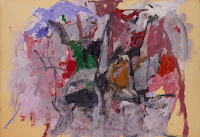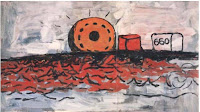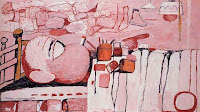Looking back at the art history of the 20th century, one tends to schematize artists within certain boundaries. Abstract Expressionists here, Pop artists there, and Minimalism yonder. But certain artists defy these categories. Retrospectively looking back at an artist’s corpus, categorizations can sometimes be evasive and lack definition. Such is the case with the artist Philip Guston.
From letters in Meyer Schapiro’s archive, it turns out that Guston and Schapiro were friends and corresponded frequently with one another.
Guston’s career traversed many periods and art movements, from Social Realism, to Abstract Expressionism, and to his final haunting late period that brought back figuration into his work. As the art historian Donald Kuspit once wrote about Guston’s unique artistic trajectory :
Guston had the guts to change, to make it genuinely new. Refusing to toe the current art party line, his fresh maverick imagery — “fresh” in every sense of the word — made him an outcast, but also brought him notoriety. He had the credibility of those who break set: he showed that it was still possible to perform the defamiliarization miracle — restore the unfamiliarity and inexplicability that life and art have before they are legitimated and sanctioned by explication and explanation — that gave the avant–garde art its credibility in the first place.

One can see this shift from his Abstract Expressionist phase to his later period. This untitled painting to the left, from the Minneapolis Institute of Arts, is from 1958 and highlights Guston’s meticulous adherence to the movements underlying aesthetic principles.
However, in 20 years time, Guston would shift gears and bring back imagery to his paintings.
In a letter found in Schapiro’s archive dated September 18, 1973, Philip Guston writes:
I have stayed close to the studio this year and a group of large pictures are the result. They stimulate me and lead me on and on. It is as if there is a plot, both in subject and plastic structure, unknown to me, but revealed as I go from painting to painting.
The painting to the right, Maverick Sun, dates from 1972 and has dimensions of  50 by 91 inches. Its barren landscape accentuates the objects in the background, giving them a sense of groundedness. While lacking any sense of context, the image still seems to evoke a narrative from the objects themselves.
50 by 91 inches. Its barren landscape accentuates the objects in the background, giving them a sense of groundedness. While lacking any sense of context, the image still seems to evoke a narrative from the objects themselves.

The painting to the left, Painter in bed, is from 1973 with dimensions of 59 by 104 inches. It too gives the subject and the objects represented a narrative structure, but one that defies any sort of narrative syntax or context.
Both paintings also characterize Guston’s beguiling and puzzling last stage, one which defied explanation but was as fresh as it was inventive.